Pio Ricci stands as a notable figure in late 19th and early 20th-century Italian art, a painter whose canvases captured the refined aesthetics and intimate moments of a bygone era. Born in Florence in 1850 and passing away in 1919, Ricci dedicated his artistic career to the creation of exquisite genre scenes and costume pieces, primarily operating within his native city, a historic cradle of artistic innovation. His work, imbued with a delicate charm and meticulous attention to detail, offers a window into the tastes and sensibilities of the bourgeois society of his time, often reflecting the lingering appeal of Rococo grace filtered through a Victorian lens.
Early Life and Artistic Formation in Florence
Pio Ricci's journey as an artist began in Florence, a city steeped in centuries of unparalleled artistic heritage. Immersed in this rich environment, he pursued formal artistic training at the prestigious Accademia di Belle Arti di Firenze (Academy of Fine Arts of Florence). This institution was a cornerstone of artistic education in Italy, and during Ricci's time, it would have exposed him to rigorous academic training, emphasizing drawing, composition, and the study of Old Masters. While specific details of his tutelage are not extensively documented, it is known that figures like Giovanni Costa, though more famously associated with the Macchiaioli movement, also had connections with the Academy, contributing to the diverse influences available to students.
The academic environment in Florence would have provided Ricci with a strong foundation in traditional techniques. This training, combined with the prevailing artistic currents of the latter half of the 19th century, shaped his stylistic development. His decision to specialize in genre painting and historical costume pieces suggests an inclination towards narrative and a romantic appreciation for the past, themes that found a receptive audience during this period. Florence itself, with its rich historical tapestry and vibrant cultural life, undoubtedly served as a constant source of inspiration for the young artist.
The Artistic Milieu of Late 19th-Century Italy
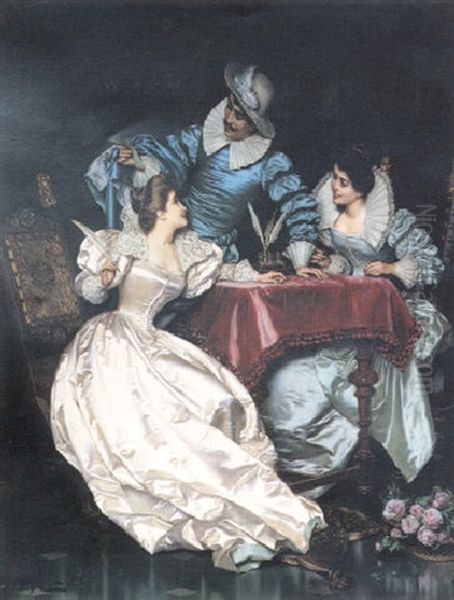
The latter half of the 19th century in Italy was a period of significant artistic ferment. The unification of Italy (the Risorgimento) had brought about new national consciousness, which also found expression in the arts. Alongside the enduring traditions of academic art, new movements were emerging. The Macchiaioli, for instance, active primarily in Tuscany from the 1850s, were Italy's answer to French Impressionism, emphasizing painting "en plein air" and capturing the effects of light and shadow through "macchie" (patches or spots) of color. Artists like Telemaco Signorini, Giovanni Fattori, and Silvestro Lega were central to this movement, often depicting scenes of contemporary Italian life and landscapes.
Concurrently, Verismo, a literary and artistic movement akin to Realism, gained traction, focusing on truthful, often gritty, portrayals of everyday life, particularly among the working classes. In painting, this translated into works that sought to depict social realities without idealization. However, alongside these progressive movements, there remained a strong market and appreciation for more traditional and decorative forms of art. Academic painting, with its emphasis on historical subjects, mythology, and polished technique, continued to be influential. It was within this complex and varied artistic landscape that Pio Ricci carved his niche.
Pio Ricci and the Neo-Rococo Revival
Pio Ricci's art is most closely associated with the Neo-Rococo style, a revivalist trend that gained popularity in the second half of the 19th century. This style harked back to the elegance, intimacy, and playful charm of 18th-century French Rococo, epitomized by masters such as Jean-Antoine Watteau, François Boucher, and Jean-Honoré Fragonard. The Neo-Rococo artists sought to emulate the refined aesthetics, delicate color palettes, and often amorous or leisurely themes of their predecessors, adapting them to contemporary tastes.
Ricci was not alone in this pursuit. He was part of a cohort of Italian painters who excelled in this genre, often referred to as "painters of the little masters" or "painters of costume." His contemporaries in this vein included figures like Francesco Beda, whose works often share a similar thematic and stylistic approach, depicting lavish interiors and elegant figures in historical dress. Arturo Ricci (no direct relation, but a contemporary working in a similar style), Vittorio Reggianini, and the French-born but Italian-active Frédéric Soulacroix were also prominent exponents of this charming and highly detailed manner of painting. These artists catered to a burgeoning bourgeois clientele that appreciated the decorative qualities and nostalgic appeal of such scenes. The Neo-Rococo offered an escape into a romanticized past, a world of gallantry, leisure, and refined sentiment, far removed from the industrializing realities of the late 19th century.
Themes and Subjects in Ricci's Oeuvre
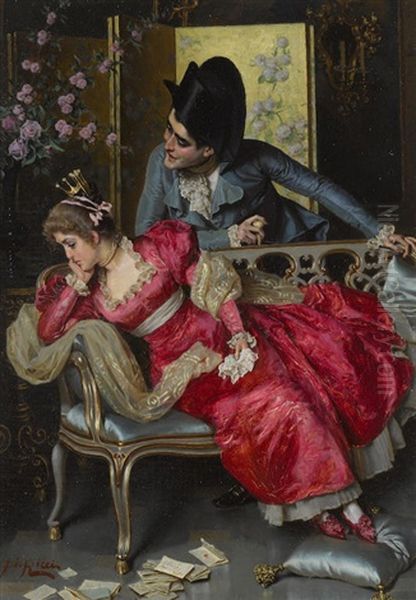
Pio Ricci's body of work is characterized by a consistent focus on intimate genre scenes and historical costume pieces. He excelled at depicting moments of everyday life, albeit often set in an idealized past, usually the 18th century, which allowed for the depiction of elaborate costumes and elegant interiors. His subjects frequently revolved around themes of courtship, music, domestic leisure, and quiet contemplation.
Common motifs in his paintings include elegantly dressed ladies and gentlemen engaged in polite conversation, musical performances, the reading or writing of letters (often love letters), and moments of playful interaction. Works such as The Courtship, Lovers' Quarrel, The Music Lesson, and The Love Letter are exemplary of these themes. He often set his scenes in richly appointed interiors, paying close attention to details of furniture, textiles, and decorative objects, which contribute to the overall atmosphere of opulence and refinement. These settings provide a stage for his characters, whose gestures and expressions convey subtle narratives of romance, amusement, or quiet reflection. The choice of subject matter reflects a desire to capture the more pleasant and picturesque aspects of social life, appealing to a taste for the charming and the sentimental.
Artistic Style and Technique
Pio Ricci's artistic style is marked by its elegance, delicacy, and meticulous attention to detail. He possessed a refined technique, characterized by smooth brushwork that rendered surfaces with a polished finish, particularly evident in the depiction of rich fabrics like silk and satin, and the gleam of polished wood or metal. His figures are gracefully drawn, often exuding an air of aristocratic poise, even when depicting more modest subjects like in Bust of a Peasant, though his primary focus remained on more genteel scenes.
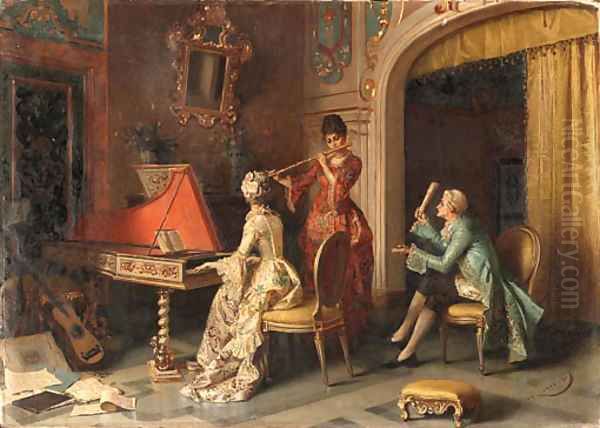
His color palette was typically soft and harmonious, often employing pastel shades or rich jewel tones that enhanced the luxurious quality of his scenes. He demonstrated a keen understanding of light, using it to highlight key elements within the composition and to create a warm, inviting atmosphere. Compositions were carefully arranged, often with a clear narrative focus, guiding the viewer's eye through the scene. While not an innovator in the vein of the Impressionists or Macchiaioli, Ricci was a master of his chosen genre, demonstrating considerable skill in creating visually appealing and emotionally resonant images. His work embodies the charm and technical polish valued by patrons of Neo-Rococo and historical genre painting. Artists like Gaetano Chierici and Federico Andreotti, while perhaps leaning more towards anecdotal peasant genre scenes, shared a similar commitment to detailed rendering and narrative clarity that was popular in Italian genre painting of the period.
Notable Works: A Glimpse into Ricci's World
Pio Ricci's oeuvre includes a significant number of paintings, many of which have appeared in art markets and private collections over the years. While a comprehensive catalogue raisonné might be elusive, several titles consistently emerge, showcasing the range and consistency of his thematic concerns and stylistic approach.
Preparing for the Ball is a quintessential example of his work, likely depicting figures in elaborate 18th-century attire making their final adjustments before a grand social event. Such scenes allowed Ricci to display his skill in rendering luxurious fabrics and capturing an atmosphere of anticipation and social grace. The Music Lesson is another recurring theme, often featuring a lady at a piano or harpsichord, perhaps with a male admirer or instructor nearby, evoking an air of refined leisure and romantic possibility.
Paintings like The Love Letter or Admiring the Letter tap into the sentimental narratives popular at the time, focusing on the intimate and emotional aspects of human relationships. The Artist's Studio - The Critic offers a glimpse into the art world itself, a subject that often interested painters. Other titles such as Man Lighting a Pipe, The Roses, The Eavesdropper, The Painting Lesson, The Lovers, Man Pinning a Rose on a Woman, A Gallant Scene, The Handsome Suitor Visiting His Maiden, The Bride-to-Be, The Siren, In the Library, The Gift, The Lovers' Tiff, Elegant Couple in an Interior, The Private Performance, Choosing the Necklace, The Solo, A Token of Love, The Suitors, True Friends, Courting Couple, Man and Woman Dancing, The Suitor with a Gift, and Sweet Dreams further illustrate his preoccupation with romantic encounters, social rituals, and moments of quiet domesticity, all rendered with his characteristic charm and technical finesse. These works collectively paint a picture of a world steeped in elegance and gentle sentiment.
Ricci's Contemporaries and Connections
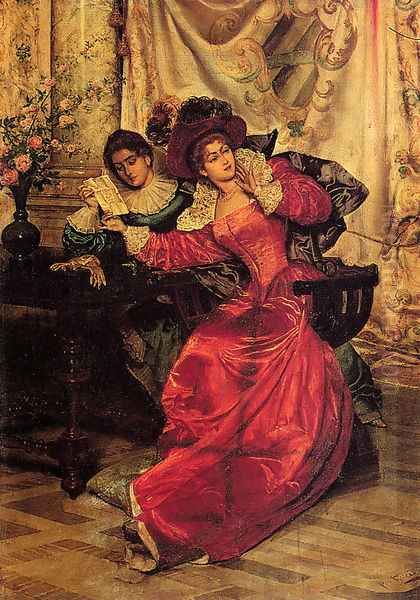
Pio Ricci operated within a vibrant artistic community in Florence and was part of a broader European trend for historical genre and Neo-Rococo painting. As mentioned, his stylistic kin included Francesco Beda, Arturo Ricci, Vittorio Reggianini, and Frédéric Soulacroix, who all specialized in similar subject matter, characterized by meticulous detail and romanticized depictions of 18th-century life. These artists often found success with international clients, particularly in England and America, where there was a strong appetite for such charming and decorative works.
Beyond this specific circle, the broader Italian art scene of the late 19th and early 20th centuries included diverse talents. While Ricci's work differed significantly from the plein-air studies of the Macchiaioli like Telemaco Signorini or the society portraits of Giovanni Boldini (who, though Italian, achieved great fame in Paris with his flamboyant style), or the Parisian scenes of Giuseppe De Nittis, they all represent different facets of Italian artistic expression during this era. Even artists like Antonio Puccinelli, whose career overlapped with Ricci's earlier period, contributed to the rich tapestry of Florentine painting, though often with different thematic concerns. The mention of Pietro Benvenuti in some contexts, an earlier Neoclassical painter, highlights the long shadow of academic tradition in Florence.
Internationally, the taste for highly finished historical and genre scenes was also evident in the work of artists like Jean-Léon Gérôme in France (though often with Orientalist or classical themes) or Lawrence Alma-Tadema in England (famous for his depictions of Roman antiquity). James Tissot, working in France and England, captured the elegant social life of his own time with a similar attention to detail and fashion. While Ricci's focus was more specifically on a romanticized past, the underlying appeal to narrative, detail, and refined sentiment was a shared characteristic across these various strands of 19th-century representational art. Eugenio Eduardo Zampighi was another Italian contemporary known for his lively and detailed genre scenes of Italian peasant life, which, while different in subject, shared the narrative and detailed approach.
Exhibitions, Recognition, and the Art Market
Information regarding extensive solo exhibitions during Pio Ricci's lifetime is somewhat scarce, which is not uncommon for artists who primarily catered to the private market rather than seeking official salon recognition as their primary goal. However, his work was known and appreciated, as evidenced by its presence in collections and its continued appearance in art auctions. One specific mention notes that his works have been exhibited at the Museo Nazionale d'Arte Medievale e Moderna in Arezzo, indicating a level of regional recognition and the preservation of his art within public institutions.
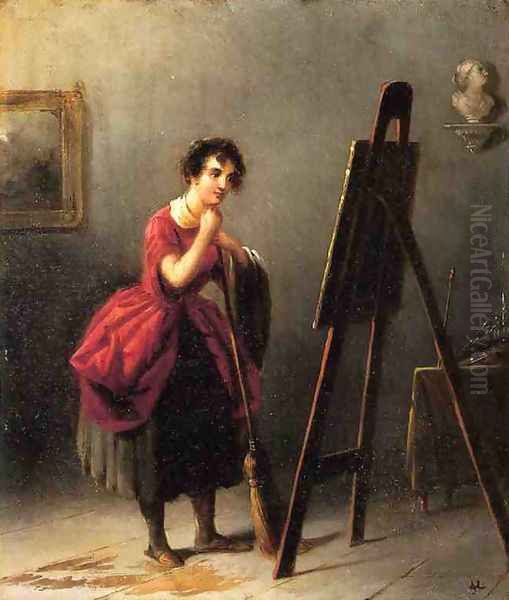
During his lifetime, artists like Pio Ricci found a ready market among the affluent middle and upper classes who sought art that was both aesthetically pleasing and reflective of a certain social aspiration or nostalgic sentiment. These paintings were well-suited to the richly decorated interiors of Victorian and Belle Époque homes. The demand for such works was international, and many Italian genre painters, Ricci likely among them, benefited from dealers who facilitated sales to collectors in Britain, France, Germany, and the United States.
Posthumously, Pio Ricci's paintings continue to be appreciated by collectors of 19th-century European art. His works regularly feature in auctions, often commanding respectable prices that reflect their decorative appeal, technical skill, and the enduring charm of their subject matter. While he may not be considered a revolutionary figure who drastically altered the course of art history, his consistent quality and appealing themes have ensured his continued presence in the art market.
Legacy and Influence
Pio Ricci's legacy lies in his contribution to the tradition of Italian genre and costume painting in the late 19th and early 20th centuries. He was a skilled practitioner of the Neo-Rococo style, creating works that are admired for their elegance, meticulous detail, and gentle romanticism. His paintings offer a charming, if idealized, vision of the past, reflecting the tastes and cultural sensibilities of the Belle Époque.
While his direct influence on subsequent generations of artists may be limited, particularly as artistic trends shifted dramatically towards Modernism in the early 20th century, his work remains a valuable testament to a particular strand of 19th-century academic and genre painting. For art historians and enthusiasts, Ricci's paintings provide insight into the popular aesthetics of his time and the enduring appeal of romanticized historical narratives. His dedication to craftsmanship and his ability to evoke a specific mood and era ensure that his art continues to be enjoyed and collected. He, along with his contemporaries in the Neo-Rococo and historical genre vein, helped to define a particular niche in European art that celebrated beauty, elegance, and the picturesque.
Conclusion: An Enduring Charm
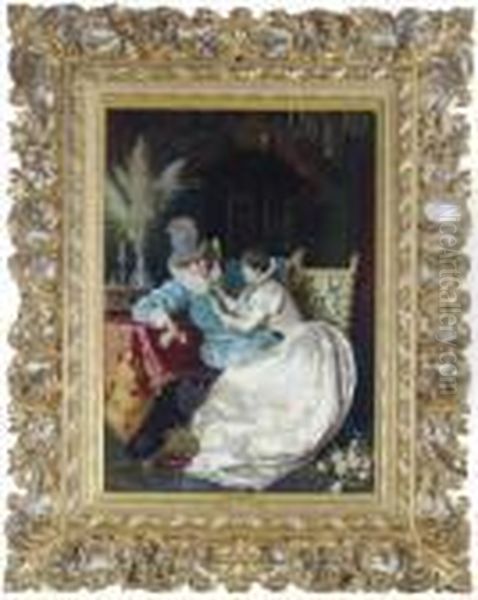
Pio Ricci was an artist who masterfully captured the spirit of refined leisure and romantic sentiment that characterized a significant segment of late 19th and early 20th-century European culture. Working primarily in his native Florence, he drew upon the city's rich artistic traditions and the prevailing taste for Neo-Rococo elegance to create a body of work that continues to delight viewers with its charm, technical skill, and meticulous attention to detail. His paintings, filled with graceful figures in historical costume, engaged in courtship, music, and other genteel pursuits, offer an idealized glimpse into a bygone era.
While perhaps not an innovator in the mold of some of his more avant-garde contemporaries, Pio Ricci excelled within his chosen genre, producing consistently high-quality works that found favor with patrons and collectors. His art stands as a testament to the enduring appeal of beauty, narrative, and romanticism in painting, securing his place as a noteworthy Italian painter of the Belle Époque, whose delicate canvases continue to evoke a sense of nostalgia and admiration.